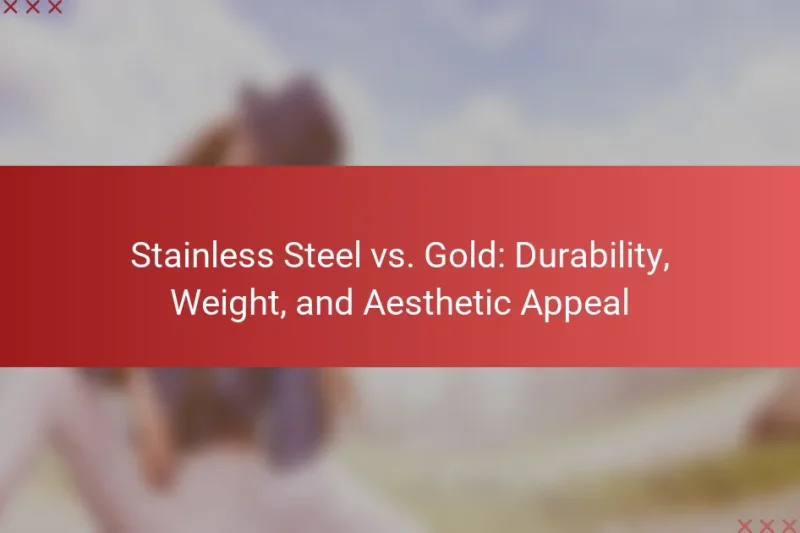Mechanical, Quartz, and Automatic movements are the three primary types of watch mechanisms, each offering unique … Movement Types: Mechanical, Quartz and AutomaticRead more
Watch Materials and Craftsmanship
When it comes to watches, the choice of materials and the level of craftsmanship play crucial roles in determining their quality and longevity. Durable materials such as stainless steel, titanium, and sapphire crystal not only enhance resilience but also contribute to the watch’s overall aesthetic. Meanwhile, exceptional craftsmanship ensures precision and meticulous assembly, elevating the timepiece to a luxury status that is highly sought after by collectors and enthusiasts alike.
Leather vs. Metal Straps: Comfort, Style and Versatility
When choosing between leather and metal straps, comfort, style, and versatility are key factors to consider. … Leather vs. Metal Straps: Comfort, Style and VersatilityRead more
Stainless Steel vs. Gold: Durability, Weight, and Aesthetic Appeal
When comparing stainless steel and gold, durability, weight, and aesthetic appeal are key factors to consider. … Stainless Steel vs. Gold: Durability, Weight, and Aesthetic AppealRead more
Material Choices: Cost, Quality and Brand Perception
Choosing the right materials for e-commerce products is crucial, as it impacts cost, quality, and brand … Material Choices: Cost, Quality and Brand PerceptionRead more
Water Resistance Ratings: Depth, Testing Standards and Usage
Water resistance ratings are essential for determining how well a watch or electronic device can endure … Water Resistance Ratings: Depth, Testing Standards and UsageRead more
Sapphire Crystal: Scratch Resistance, Clarity and Longevity
Sapphire crystal is renowned for its remarkable scratch resistance, clarity, and longevity, making it a favored … Sapphire Crystal: Scratch Resistance, Clarity and LongevityRead more
Swiss vs. Japanese Watches: Craftsmanship, Precision and Heritage
Swiss and Japanese watches represent two distinct philosophies in horology, each with its own heritage and … Swiss vs. Japanese Watches: Craftsmanship, Precision and HeritageRead more
What are the best watch materials for durability?
The best watch materials for durability include stainless steel, titanium, sapphire crystal, ceramic, and carbon fiber. Each of these materials offers unique properties that enhance the longevity and resilience of a watch against wear and tear.
Stainless steel
Stainless steel is a popular choice for watch cases due to its strength and resistance to corrosion. It typically contains chromium, which helps prevent rust and maintains a polished appearance over time.
When selecting a stainless steel watch, look for 316L grade, which is commonly used in high-quality timepieces. This grade offers excellent resistance to scratches and is less likely to irritate the skin.
Titanium
Titanium is known for being lightweight yet incredibly strong, making it an excellent alternative to stainless steel. It is highly resistant to corrosion and is often used in sports and diving watches.
One of the key benefits of titanium is its hypoallergenic properties, making it suitable for those with sensitive skin. However, it can be more prone to scratches compared to stainless steel, so consider your lifestyle when choosing this material.
Sapphire crystal
Sapphire crystal is a synthetic material that is highly valued for its scratch resistance and clarity. It is made from aluminum oxide and is significantly harder than mineral glass, making it ideal for watch faces.
While sapphire crystal is durable, it can shatter upon impact. Therefore, ensure that your watch is designed to protect the crystal from accidental drops or hits.
Ceramic
Ceramic is a lightweight and scratch-resistant material often used in watch cases and bracelets. It is available in various colors and finishes, allowing for aesthetic versatility while maintaining durability.
One drawback of ceramic is its brittleness; it can chip or crack if subjected to severe impacts. However, its resistance to fading and scratching makes it a popular choice for luxury watches.
Carbon fiber
Carbon fiber is a composite material known for its exceptional strength-to-weight ratio. It is often used in high-performance watches, particularly those designed for sports and outdoor activities.
This material is resistant to scratches and corrosion, but it can be more expensive than traditional materials. When considering a carbon fiber watch, look for models that combine it with other durable materials for added protection.
How does craftsmanship affect watch quality?
Craftsmanship significantly influences watch quality by determining the precision, durability, and overall aesthetic of the timepiece. High-quality craftsmanship often results in better materials, meticulous assembly, and attention to detail, which collectively enhance the watch’s performance and longevity.
Handcrafted vs. mass-produced
Handcrafted watches are typically made by skilled artisans who pay close attention to each component, resulting in unique pieces with superior quality. In contrast, mass-produced watches are manufactured in large quantities, often sacrificing detail and personalization for efficiency and cost-effectiveness.
When choosing between handcrafted and mass-produced options, consider your budget and the value you place on uniqueness versus affordability. Handcrafted watches may come with a higher price tag, often ranging from hundreds to thousands of dollars, while mass-produced models can be found for much less.
Movement types: automatic vs. quartz
The movement of a watch is crucial to its functionality and maintenance. Automatic movements are powered by the motion of the wearer’s wrist, while quartz movements use a battery to keep time. Automatic watches are often favored for their craftsmanship and longevity, while quartz watches are appreciated for their accuracy and low maintenance.
When selecting a movement type, consider how often you wear the watch and your preference for maintenance. Automatic watches may require regular servicing every few years, whereas quartz watches typically only need battery replacements every couple of years.
Finishing techniques
Finishing techniques play a vital role in the overall appearance and quality of a watch. Techniques such as polishing, brushing, and coating can enhance the visual appeal and protect the materials used. High-end watches often feature intricate finishing that showcases the craftsmanship involved.
When evaluating finishing techniques, look for smooth edges, consistent surfaces, and attention to detail. A well-finished watch not only looks better but also indicates a higher level of craftsmanship, which can affect its resale value and longevity.
What are the most popular luxury watch brands?
The most popular luxury watch brands are known for their exceptional craftsmanship, heritage, and prestige. Brands like Rolex, Omega, Patek Philippe, and Audemars Piguet consistently rank among the top choices for collectors and enthusiasts alike.
Rolex
Rolex is synonymous with luxury and precision, renowned for its iconic designs and robust performance. Established in the early 20th century, Rolex watches are often seen as a status symbol and are known for their durability and reliability.
Key models include the Submariner, Daytona, and Datejust, each offering unique features and styles. When considering a Rolex, look for the authenticity of the timepiece and its service history, as these factors significantly influence value.
Omega
Omega is celebrated for its innovation and has a strong connection to space exploration, famously being the first watch on the moon. The brand combines elegance with advanced technology, making it a favorite among watch enthusiasts.
Popular models like the Speedmaster and Seamaster showcase Omega’s commitment to quality and precision. When purchasing an Omega, consider the model’s heritage and any limited editions, as these can enhance collectibility and value.
Patek Philippe
Patek Philippe is often regarded as the pinnacle of luxury watchmaking, known for its intricate craftsmanship and timeless designs. The brand produces a limited number of watches each year, contributing to its exclusivity and desirability.
Models such as the Nautilus and Calatrava are highly sought after for their elegance and complexity. When investing in a Patek Philippe, ensure you have documentation and provenance, as these details can significantly affect resale value.
Audemars Piguet
Audemars Piguet is famous for its bold designs and pioneering spirit, particularly with the introduction of the Royal Oak, which revolutionized luxury sports watches. The brand is known for its meticulous attention to detail and artisanal craftsmanship.
When considering an Audemars Piguet, pay attention to the model’s rarity and condition, as limited editions often command higher prices. Familiarize yourself with the brand’s history and signature features to make an informed purchase.
How to choose a watch based on materials?
Choosing a watch based on materials involves considering durability, comfort, and style. The right material can enhance the watch’s longevity and fit your lifestyle needs.
Consider lifestyle and usage
Your lifestyle plays a crucial role in selecting the appropriate watch material. For instance, if you lead an active life or work in rugged environments, opt for robust materials like stainless steel or titanium. Conversely, if you prefer formal occasions, leather or gold might be more suitable.
Think about the activities you engage in regularly. Water-resistant materials like ceramic or rubber are ideal for swimmers, while dress watches often feature precious metals that complement formal attire.
Assess weight and comfort
The weight of a watch can significantly impact your comfort throughout the day. Lighter materials, such as titanium or certain plastics, are great for those who dislike the feeling of a heavy watch on their wrist. In contrast, heavier metals like stainless steel may provide a sense of durability but can feel cumbersome.
When trying on watches, pay attention to how they feel on your wrist. A comfortable fit is essential, especially if you plan to wear the watch for extended periods. Consider adjustable straps or lighter alternatives if comfort is a priority.
Evaluate scratch resistance
Scratch resistance is an important factor in maintaining the watch’s appearance over time. Materials like sapphire crystal are highly resistant to scratches, making them ideal for daily wear. In contrast, mineral glass is more prone to scratches and may require more careful handling.
When evaluating scratch resistance, consider your daily activities. If you work in environments where your watch may come into contact with hard surfaces, prioritize materials known for their durability. Regular maintenance can also help preserve the watch’s finish and functionality.






